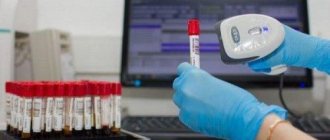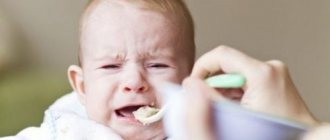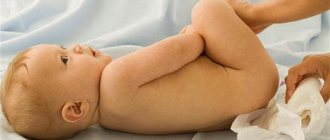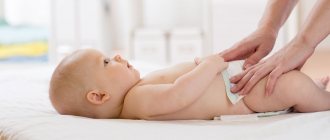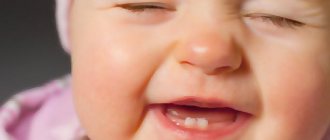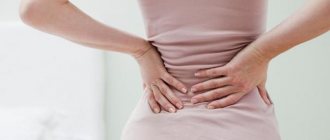Causes
Diarrhea with mucus is a symptom whose appearance indicates damage to the digestive system. Excessive mucus secretion is characteristic of diseases of the large intestine - colitis. This is due to the fact that in the wall of the colon there are many more goblet cells, which are responsible for the production of mucous secretion1.
The causes of diarrhea with mucus in a child can be divided into infectious and non-infectious2.
Up to contents
Infectious causes
Intestinal infections last 1-3 weeks2. Infectious factors include viruses, bacteria and pathological fungi that affect the intestinal mucosa and cause diarrhea2. Also, often mucous diarrhea is a manifestation of the active activity of parasites in the intestines2. In addition to mechanical injury to the intestinal wall, worms can have a toxic effect on the body with the substances they secrete. Parasites can provoke allergies and maintain constant inflammation in the gastrointestinal tract9.
Depending on the mechanism of development, the following types of diarrhea are distinguished:
- Secretory . The basis of diarrhea of secretory origin is enteritis - damage to the wall of the small intestine, primarily of viral origin. With this pathology, stool becomes liquid and watery14.
- Invasive diarrhea. Invasive is associated with damage to the large intestine by pathogenic bacteria - for example, Salmonella, Shigella or Escherichia. They penetrate the intestinal wall and cause active inflammation - colitis, which is manifested by the appearance of diarrhea with mucus14
It is the large intestine that normally ensures the formation of stool, so disruption of its function leads to the appearance of loose stools with abundant mucus1.
Up to contents
Non-infectious causes
Non-infectious diarrhea lasts more than 3 months and becomes chronic2.
Mucous diarrhea in a child often occurs as a result of an allergic reaction2,11. In young children, the main food allergens are cow's and goat's milk proteins. The list of allergens is expanding as new dishes are introduced; schoolchildren and teenagers are often allergic to eggs and gluten-containing products10. Food allergies can be triggered by an unbalanced diet, frequent or, conversely, too infrequent meals11.
Liquid, light stool mixed with mucus and blood is observed in the following cases2:
- Ulcerative colitis is a disease in which active damage to the mucous and submucosal layer of the large intestine occurs with the formation of ulcers. It is based on a disruption of the body’s immune response, which leads to chronic inflammation16.
- Crohn's disease is a long-term pathology that occurs with exacerbations. Unlike ulcerative colitis, this disease can affect all parts of the digestive system. In children and adolescents, the disease begins in the large intestine. In this case, chronic inflammation affects all layers of the intestinal wall16,17.
- Juvenile polyposis is the formation of multiple polyps in the small and large intestines, in which epithelial glands that produce mucus are actively working5.
Up to contents
Irritable bowel syndrome
Another cause of diarrhea in children and adolescents is irritable bowel syndrome. It develops due to a functional disorder of the digestive system. In this case, the child usually experiences mucous diarrhea with particles of undigested food1.
In most cases, symptoms appear in the morning, immediately after breakfast - for example, on the way to school. This phenomenon is called “morning rush syndrome.” In this case, the teenager first passes formed stool, then the stool becomes mushy or liquid feces are released. After bowel movements, the child feels well and, as a rule, diarrhea does not recur during the day1.
Up to contents
Antibiotic-associated diarrhea in children
It is customary to separately distinguish antibiotic-associated diarrhea - a bowel disorder that occurs while taking antimicrobial drugs or several months after a course of treatment2. When using drugs, the composition of the intestinal microflora is disrupted - dysbacteriosis develops. Against this background, clostridia actively multiply, and pseudomembranous colitis develops. Because of this, the child develops painful, repeated diarrhea with the release of mucus or blood6,15.
Up to contents
Errors in the diet
In the first months of life, the baby should consume either breast milk or an adapted formula. Diarrhea in a breastfed baby can develop due to the mother's diet.
Products such as zucchini, pumpkin, plums and prunes, and beets improve bowel movements, which is important for a woman during the postpartum period. But the active substances pass into breast milk. And what causes improved peristalsis in the mother will lead to diarrhea in the baby.
If a child receives an adapted formula, then parents should strictly adhere to the recommended dosages when diluting the product and age standards. In addition, the mixtures are selected individually and perhaps this particular one was not suitable for the baby.
Excess nutrition can also lead to frequent bowel movements of undigested formula or milk.
Symptoms of diarrhea with mucus
Diarrhea is not an independent disease, but a separate symptom. When it appears, it is important for parents to pay attention to the frequency of stool in the child, its abundance and consistency.
Normally, a child over one year old should have stool no more than 1-2 times a day. Feces are usually dark brown, shaped, and hard. There should be no visible impurities. With diarrhea, the stool becomes thinner, sometimes to the point where there are no solid particles at all13.
Diarrhea with green mucus most often occurs due to a bacterial infection3. When the large intestine is affected, stools are usually repeated, but not too abundant. In addition to mucus, it sometimes contains blood or pus2,7.
Food allergies can manifest as colicky abdominal pain, frequent loose stools with the discharge of glassy mucus11. The persistence of loose stools is a reason to suspect more serious problems, primarily of a non-infectious nature2.
With an intestinal infection, diarrhea is accompanied by abdominal pain - usually it is quite strong and cramping. It is painful for the child to go to the toilet, sometimes he has a false urge to defecate - tenesmus3.
The situation requires close attention from parents if loose, mucous stools are accompanied by additional symptoms7:
- Vomiting of undigested food debris or bile, sometimes mixed with blood;
- Increased body temperature – fever;
- Chills and weakness;
- Rare urge to urinate;
- Flatulence - bloating;
- Body aches, muscle pain;
- Skin rash;
- Loss of appetite;
- Drowsiness or, conversely, emotional excitement;
- The stool is black.
With severe diarrhea, children become dehydrated and complain of extreme thirst. Due to malabsorption of nutrients due to diarrhea, the child loses weight7.
If episodes of diarrhea with mucus recur and are accompanied by other alarming symptoms, it is necessary to show the child to a pediatrician7. The doctor will make the correct diagnosis and prescribe adequate treatment.
Up to contents
What is considered diarrhea?
According to the World Health Organization (WHO), diarrhea is the passage of liquid stool 3 or more times a day5. In this case, you should pay special attention not only to the frequency of emptying, but also to the consistency of the stool. Frequent passage of formed feces is not considered diarrhea5, that is, with diarrhea, the stool not only becomes more frequent, it becomes more watery, liquid, and sometimes it may contain impurities (mucus, blood or undigested food particles)3,4.
Since it is not always easy to understand how shaped a stool is, experts have created a special scale - the Bristol Stool Rating Scale. It includes 7 categories that classify feces depending on their appearance1.
| Type 1 | Isolated, hard-to-pass, hard lumps similar to sheep feces |
| Type 2 | Stool in the shape of a cylinder consisting of many lumps |
| Type 3 | Feces in the shape of a cylinder, covered with striations, smaller in diameter than in the second case |
| Type 4 | Sausage-shaped feces with a smooth surface |
| Type 5 | Individual soft, shaped lumps move easily along the rectum |
| Type 6 | Fecal masses are porous, represented by unformed flakes |
| Type 7 | Stool is liquid, watery, without dense elements |
Diarrhea, according to the scale, corresponds to types 5, 6 and 73.
How is the child examined?
In most cases, diarrhea with mucus does not require any specific examination7. The doctor assesses the child’s condition, examines him and, based on this, makes recommendations for treatment. To distinguish infectious causes of mucous diarrhea from non-infectious ones, the pediatrician prescribes laboratory tests and instrumental research methods4,7.
For a correct diagnosis, you should inform the doctor about the child’s eating habits, recently taken medications, and a tendency to allergies2.
Up to contents
Causes of diarrhea in a newborn
The main reasons for the development of diarrhea in a newborn can be:
- Changes in the diet of a nursing mother.
- Infections.
- Mom taking medications.
- Antibiotics.
- Poisoning.
- Surgical reasons.
- Teething (for older children).
- Allergies, dysbacteriosis.
Let's consider each reason separately.
E. Komarovsky's opinion - what should mom eat?
A well-known doctor reminds that diarrhea in infants fed breast milk is often caused by poor nutrition of the mother. This applies not only to products that have a laxative effect, but also to possible allergens. Komarovsky urges nursing mothers to experiment less with nutrition and limit as much as possible cocoa, citrus fruits, strawberries, coffee and other products that can act as allergens.
According to the doctor, everything that a mother eats certainly ends up in her milk. That is why you should not eat foods that can worsen the smell or taste of milk. As for diarrhea in babies, the mother's consumption of white cabbage or legumes can make the baby's stool looser and more frequent. When trying any product, the mother should monitor the baby, and if the baby does not have a rash and the stool has not changed, then you can increase the amount of the product in the diet.
Infections
Infections can be bacterial or viral. A child can become infected with them if hygiene rules are not observed sufficiently. The mother should wash her breasts well before feeding, monitor the hygiene of surrounding objects and the baby’s bed, and not allow the baby to be held by strangers in outer clothing in the first weeks. In addition, if the mother herself becomes infected with the infection, it can be passed on to the baby through her milk.
Sterilization of bottles (when feeding formula) is also an important hygienic operation to prevent unwanted infections.
Mom taking medications
Any medications enter the baby’s body through milk. This is especially true for antibiotics - they instantly provoke dysbiosis (an imbalance of beneficial bacteria in the intestines) and will certainly provoke diarrhea.
If antibiotics were prescribed to the child himself, then they are the cause of loose stools. Consult your pediatrician and tell them about the unpleasant consequences of taking medications. Perhaps he will make another appointment or prescribe drugs that correct the microflora.
Surgical reasons
Surgical reasons include:
- abnormal intrauterine development of the intestine;
- appendicitis (accompanied by severe abdominal pain in a child);
- pathology of the pancreas.
A careful examination of the newborn by the doctor and the use of all available diagnostic tools will help to recognize the cause of the disorder in time and eliminate it.
Teething
Children begin to erupt their first teeth at different ages. Full range: from three months to eleven. When teething, salivation reflexively increases, and it is this that provokes the development of diarrhea. A large amount of fluid enters the lower gastrointestinal tract and thins the stool. As a rule, after the tooth comes out, salivation stops and stool returns to normal.
One cause of teething diarrhea is bacterial infection. The baby begins to put everything in his mouth, and if the hygiene of the surrounding area is insufficient, a microbe may enter.
Allergies
Allergies can develop if a nursing mother contains certain foods in her diet:
- Citrus.
- Chocolate, sweets.
- "Overseas" fruits.
- Red vegetables, etc.
You should also pay attention to the formula that the baby is fed (with artificial feeding) - it can also cause allergic reactions.
Treatment
Treatment of diarrhea in a child should be carried out by a specialized specialist - a pediatrician or pediatric gastroenterologist. Only a doctor can adequately assess the severity of the patient’s condition and prescribe rational therapy.
If the disease is mild, the child is given more fluids to drink to quickly make up for the deficiency. If severe dehydration develops, hospitalization and intravenous saline solutions will be required3,7.
Diet therapy
In order for intestinal function to recover faster, it is important to monitor the child’s nutrition. If the diarrhea is mild and there are no signs of intoxication, in older children the amount of food should be reduced by 15-20%. The food must be well prepared; it is better to serve the dish pureed or mashed. From 3-5 days you can return to your previous diet. With moderate diarrhea, in the first days the amount of food is reduced by 20-30%, and over the course of 4-6 days they gradually return to the usual menu14.
It is advisable not to consume foods that increase diarrhea. Food containing soft fiber should be added to the menu14.
Diet for diarrhea with mucus in a child14
| Products to exclude | Recommended Products |
|
|
Up to contents
What happens to a newborn's intestines in the first days of life?
Every adult's intestines are normally populated with the required number of microorganisms (bacteria), which are not harmful, but on the contrary, beneficial. They actively reproduce and form the intestinal microflora, which is the basis for a healthy body.
But in a newborn, there are no bacteria in the intestines; they begin to appear only in the first days of his life, or rather in the first hours. In the uterine cavity, the baby’s body was in a sterile state, and, coming out of the mother’s womb, with the first portion of inhaled air and contact with it, he receives the first doses of bacteria. They immediately settle on his skin and enter the body with inhaled air.
Mother's milk contains colostrum, which immediately penetrates the baby's gastrointestinal tract, populates it with beneficial bacteria and helps the germ of microflora to successfully form.
In the first days of a child's life, loose stools are entirely explained by breastfeeding. The mother produces milk only on the third day, but in the meantime the baby sucks colostrum, which has a natural laxative effect. This is necessary so that the child’s body is cleansed as quickly as possible of the waste that has accumulated in it during intrauterine growth. The first black feces are what they are.
After being freed from waste, a period of active formation of digestion begins in the child’s life. It is often accompanied by colic and pathological gas formation. After the microflora is fully formed, all problems go away and the baby stops suffering from tummy disorders. That is why irregular loose stools in the first weeks of life are rather the norm, because the body is just learning to digest food and may malfunction. But there are also cases when you really need the help of a specialist - more on that later.
